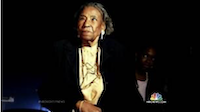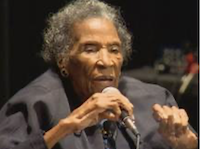
Amelia Boynton Robinson, born Amelia Isadora Platts, was born on August 18th, 1911 in the city of Savannah, Georgia. Her childhood was framed by her parents’ religious values, and her many years spent at Church sparked an interest in women’s suffrage. Her parents’ progressive mindset encouraged Robinson to pursue an education, first at what is now called Savannah State University (1925), and later as a transfer to Tuskegee Institute (1927), to obtain a degree in home economics. Ten years later, Robinson met her first husband, Samuel Willliam Boyton, in Selma, Alabama, with whom she adopted her two nieces, Sharon Seay and Germaine Bowser, and had a biological son, Bruce Carver Boynton. Segregation and racial prejudices ran rampant during Robinson’s early life. Many bodies of legislation were passed to prevent the black community from having any sort of representation in government. For example, the Grandfather clause allowed uneducated white men to vote but denied that same privilege to Black men. Redlining also became prominent, discriminating against Black entrepreneurs and segregating them from the American dream. However, in 1934, after the Voting Rights Act of 1965, Robinson was able to register to vote, beginning her career as an American civil rights activist. In 1958, one of her sons, Bruce Boynton, was arrested for supposedly trespassing, after attempting to purchase food in Richmond, Virginia. By the court of law, Bruce was found guilty and jailed, before ultimately dying of natural causes in 1963. Bruce’s story was the epitome of deep-rooted injustice in the United States government. At this time, the Civil Rights Movement was prominent and its influence was growing exponentially. Affected by her son's death and the injustice that preceded it, Robinson made her home a hub for Selma’s civil rights movement. There, Black citizens joined her in creating effective strategies to triumph over white America. In 1964, Robinson ran for Congress as a Democratic Candidate for a seat in the US House of Representatives and became the first female African American to do so. She was so well-liked that she received 10% of all votes.
Even then, Robinson lost. But despite this, Robinson refused to stop there. Working with Martin Luther King Junior and members of the Southern Christian Leadership Conference, she continued to organize protests and demonstrations. The most notable marches were those to Montgomery, Alabama. Shortly after, Robinson noticed that although Selma had a population that was 50% black, only 300 citizens were registered to vote, a feeble minority to the total population of 17,000 people. However, after the three Selma to Montgomery marches, this number rose to 11,000, due to the passing of the Voting Rights Act of 1965.

The marches began on February 26, 1965, when activist Jimmie Lee Jackson was shot and killed by a state trooper during a peaceful protest. In response to the violence, James Bevel, leader of the Southern Christian Leadership Conference, called for the first march. On March 7th, 1965, state troopers attacked several unarmed marchers during the peaceful demonstration. The violence imposed during this march was nicknamed the day “Blood Sunday.” At the march, the police beat Robinson until she was unconscious, an image the media quickly spread; Black citizens rallied together, fighting on behalf of Robinson. The second march occurred on March 9th, 1965. Although police and marchers clashed, the troopers stepped aside, allowing Martin Luther King to lead marchers to the church, in the hope of seeking protection from the troopers. Unfortunately, that same night, a group of white people beat and eventually killed James Reeb, a civil rights activist from Boston, who traveled to Alabama to join the march. The entire nation responded to “Blood Sunday” with mourning, and demanded protection and federal voting rights. Soon after, President Lyndon Johnson requested the introduction of the Voting Rights Act and vowed to protect the protestors.
After her first marriage to William Boynton ended as he died, in 1969, Boynton remarried to Bob W. Billips, and later, after Billips died in 1973, to James Robinson in 1976.

Although Amelia Boynton Robinson made a substantial contribution to the civil rights struggle, she is not as well known as some other civil rights advocates. She was a woman, and women were frequently disregarded and underrepresented in the Civil Rights Movement. Furthermore, her actions were concentrated in the South, which was not as heavily covered by the national media as events in the North.
There have been initiatives in recent years to highlight Amelia Boynton Robinson's accomplishments and elevate her status as a pivotal role in the Civil Rights Movement. In 2015, she was awarded the Presidential Medal of Freedom, and in 2020, the United States Congress passed the Amelia Boynton Robinson Congressional Gold Medal Act, which honored her commitment to securing Black citizens’ right to vote.
Why Did I Choose to Research Amelia Boynton Robinson?
I chose to write my article on Amelia Boynton Robinson to share her incredible life with others. Oftentimes, work like hers is undermined, as male counterparts receive credit for their work. I hope that, by the end of this article, readers understand the significance of Robinson’s life and can begin to acknowledge her impact on the success of the Civil Rights movement and attribute much more of the Civil Rights movement to her.
Works Cited
Associated Press. "Gardner Yanks honor for Civil Rights leader." February 8, 1992. https://news.google.com/newspapers?id=p35fAAAAIBAJ&pg=5612,2337571.
Brown, Nikki L. M, and Barry M. Stentiford. The Jim Crow Encyclopedia., Westport, Conn.: Greenwood Press, 2008.
Kirk, John A. Martin Luther King Jr. Oxfordshire [England]: Routledge, 2013.
Robinson, Amelia Boynton Bridge across Jordan. Rev. ed. Washington, DC: Schiller Institute, 1991.
Simmons, Ann M. "Memories of Selma and 'Bloody Sunday': 'They came with nightsticks." Los Angeles Times. https://www.latimes.com/nation/la-na-selma-activist-20150305-story.html.
This article was published on 1/24/24